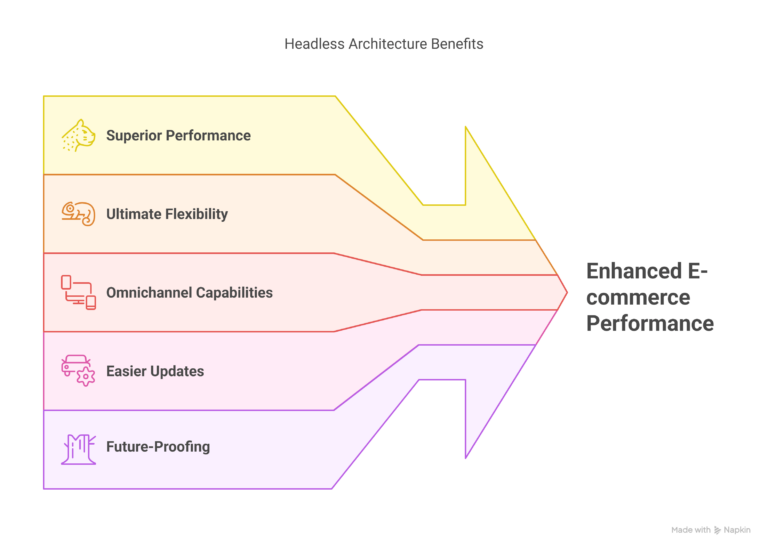Greetings! I'm Aneesh Sreedharan, CEO of 2Hats Logic Solutions. At 2Hats Logic Solutions, we are dedicated to providing technical expertise and resolving your concerns in the world of technology. Our blog page serves as a resource where we share insights and experiences, offering valuable perspectives on your queries.
QUICK SUMMARY
Headless commerce separates your frontend from your backend, giving you ultimate flexibility for creating unique customer experiences across any touchpoint. While it offers superior performance, flexibility, and omnichannel capabilities, it typically requires more technical resources and a higher initial investment. It’s ideal for growing businesses with unique needs or those hitting limitations with traditional platforms.
Are you feeling stuck with your current e-commerce platform? Perhaps your site is loading slowly, or you’re struggling to deliver consistent experiences across different devices.
If you’re nodding along, you’re not alone. Many businesses are facing the same challenges, which is why “headless commerce” has become such a hot topic.
But is headless commerce worth the investment? Let’s cut through the hype and get to the real benefits and challenges.
What is Headless Commerce?
Headless commerce separates your customer-facing frontend (website, app, etc.) from your backend commerce engine (products, inventory, checkout). These components communicate through APIs, giving you unprecedented flexibility and performance.
The Big Question: Is Headless Commerce Worth It?
Let’s break this down into concrete pros and cons:
Pros of Headless Commerce

- Superior Performance and Speed
Traditional e-commerce platforms often load slowly because they’re carrying the weight of both frontend and backend systems simultaneously. With headless architecture, your frontend can be optimized for speed independently.
Real Example: When a luxury fashion retailer moved to a headless architecture, they saw a 62% improvement in page load speed, which directly contributed to a 33% increase in their conversion rate.
- Ultimate Flexibility and Customization
Want to create a unique shopping experience that doesn’t look like every other e-commerce store? Headless gives you that freedom.
- True Omnichannel Capabilities
Headless architecture allows you to deliver consistent experiences across any touchpoint, website, mobile app, kiosk, voice assistant, or whatever comes next.
- Easier Updates and Reduced Risk
Since your frontend and backend are separate, you can update one without affecting the other. This means:
- Frontend design changes don’t risk breaking your checkout process
- Backend updates don’t force you to rebuild your customer-facing interface
- A/B testing becomes much safer and easier to implement
- Future-Proofing Your Business
New customer touchpoints keep emerging. Ten years ago, no one was shopping through voice assistants or social media platforms. With headless commerce, you’re ready to expand to new channels as they become relevant.
Cons of Headless Commerce

- Higher Initial Investment
Headless solutions typically require more upfront investment than all-in-one platforms.
Example: A mid-sized retailer might spend $50,000-$150,000 to implement a headless solution, compared to $20,000-$50,000 for a traditional platform.
- More Technical Resources Required
You’ll need developers who understand both frontend and API technologies. This usually means:
- Higher skilled development team requirements
- Potentially increased personnel costs
- More complex project management
- Multiple Systems to Manage
Instead of one platform doing everything, you’ll have separate systems handling different aspects of your e-commerce business.
| Traditional Commerce | Headless Commerce |
| One system to manage | Multiple specialized systems |
| Lower technical complexity | Higher technical complexity |
| Limited customization | Unlimited customization |
| Slower performance | Faster performance |
- Potential for Increased Complexity
With more moving parts comes more potential for complications, especially if you don’t have the right team in place.
Pro Tip: Before going headless, map out all your current systems and how they’ll need to interact in the new architecture. This exercise often reveals integration challenges you’ll need to address before migrating.
Who Should Consider Headless Commerce?
Headless commerce isn’t for everyone. You might be a good candidate if:
- Your business is growing rapidly and hitting limitations with your current platform
- You need a truly unique customer experience that template-based platforms can’t deliver
- You’re selling across multiple channels (web, mobile, in-store, IoT devices)
- Your current site has performance issues affecting conversion rates
- You have access to technical resources (either in-house or through a partner)
Want to see headless commerce in action?
Headless Magento
Magento (now Adobe Commerce) has been a powerhouse in e-commerce for years, but many businesses are exploring headless Magento implementations.
Benefits of Headless Magento
- Keep What Works, Improve What Doesn’t
Magento’s backend strengths in product management, promotions, and checkout logic remain intact, while you gain the freedom to build a cutting-edge frontend.
- Improved Performance
Traditional Magento stores can be notoriously slow. A headless implementation can dramatically improve page load times.
- Modernized Developer Experience
Frontend developers can work with modern frameworks like React, Vue, or Next.js rather than being forced to use Magento’s template system.
Real-World Success Stories
A women’s clothing retailer, switched to a headless architecture and saw:
- 24% increase in mobile conversion rate
- 16% increase in overall revenue
- 38% faster page load times
How to Determine if Headless Commerce is Right for You
Ask yourself these questions:
- Are your customers demanding a better digital experience?
- Are you struggling with site performance issues?
- Do you need to sell across multiple channels?
- Is your current platform limiting your growth?
- Do you have access to technical resources?
If you answered “yes” to at least three of these questions, headless commerce could be a valuable investment for your business.
Getting Started With Headless Commerce
If you’re considering the move to headless commerce, here’s a simplified roadmap:
- Audit Your Current Setup: Understand what’s working and what’s not with your existing platform.
- Prioritize Your Goals: Is it speed? Flexibility? Omnichannel capabilities? Know what you’re trying to solve.
- Choose Your Tech Stack: Select a headless commerce backend and decide on your frontend technology.
- Start Small: Consider implementing headless commerce for one part of your site first.
- Partner With Experts: Work with developers and agencies experienced in headless implementations.
Pro Tip: Rather than going fully headless immediately, many businesses succeed with a “progressive migration” approach, moving one section of their site at a time to the new architecture while keeping the rest on the traditional platform.
Ready to Explore Headless Commerce for Your Business?
At 2HatsLogic, we’ve helped dozens of businesses successfully implement headless commerce solutions that drive real results. Our team understands both the technical complexities and the business implications of going headless.
Whether you’re curious about headless Magento, exploring a complete platform change, or just trying to understand if headless is right for you, we’re here to help.
Contact us today for a free consultation to discuss your specific needs and how headless commerce might benefit your business.
FAQ
How much does headless commerce typically cost?
Implementation costs range from $50,000 to $500,000+ depending on complexity, with ongoing maintenance costs typically 20-30% higher than traditional platforms.
How long does it take to implement headless commerce?
Most implementations take 3-6 months for a medium-complexity store, though this varies based on your specific requirements.
Can small businesses benefit from headless commerce?
Yes, but the investment makes more sense when you're doing at least $1-2 million in annual online revenue or have specific needs that traditional platforms cannot address.
Will we need to hire new developers?
Most likely, you'll need developers familiar with modern frontend frameworks and API integration. This could mean training your existing team or bringing in new talent.
What platforms work well for headless commerce?
Popular headless commerce platforms include Commercetools, BigCommerce, Shopify Plus (with headless capabilities), Adobe Commerce (Magento), and Elastic Path.
Table of contents
- What is Headless Commerce?
- The Big Question: Is Headless Commerce Worth It?
- Who Should Consider Headless Commerce?
- Headless Magento
- Real-World Success Stories
- How to Determine if Headless Commerce is Right for You
- Getting Started With Headless Commerce
- Ready to Explore Headless Commerce for Your Business?

Related Articles







